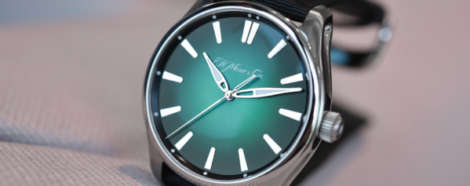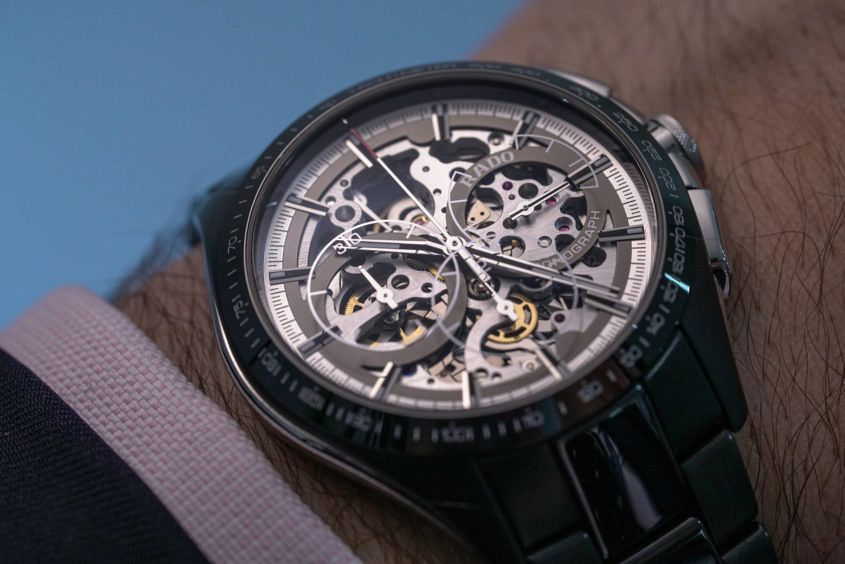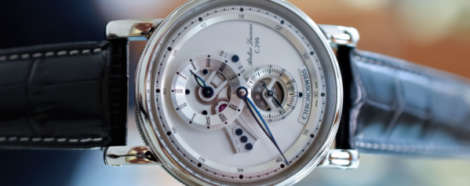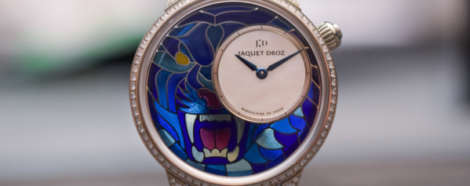Hands-on – Omega Speedmaster Dark Side of the Moon Apollo 8
Fifty years ago, on Christmas Eve 1968, Apollo 8 became the first manned spacecraft to orbit the Moon and the three astronauts on board the first men to witness the far, or dark side, of our celestial neighbour. To celebrate this encounter, in 2013 Omega dedicated an entire collection of black-themed Speedmasters known as the Dark Side of the Moon. During Baselworld 2018, Omega presented the latest crew member of this collection, the new Apollo 8. A hybrid of sorts, the Apollo 8 shares the black ceramic case of the Dark Side of the Moon collection but has jettisoned its automatic co-axial engine in favour of Omega’s legendary calibre 1861, the manual-wound movement of the classic Moonwatch.




 At Baselworld this year we saw Rado doubling down with two new limited-edition versions of their everyday and sporty HyperChrome chronograph. The first version, the HyperChrome Bronze, takes its form inside a case crafted from a combination of high-tech ceramic and bronze. While the second opens up its ceramic case, foregoing a traditional dial and skeletonizing the movement. Earlier this week I went hands-on with the patina-friendly bronze version, and today it’s time to take a peek at (and through) the stripped back dial of the aptly named HyperChrome Skeleton. Vital statistics Consisting of an inner monobloc ceramic case with stainless-steel side inserts, and chronograph pushers and crown, the 45mm case is water resistant to 100 metres. Steel sides are polished, while the ceramic components are fired with a black pigment inside a high-tech oven at 1450°C, creating the super hard and lightweight case that is then extensively sandblasted to a matt finish – except for the ceramic bezel, which is polished and engraved with a tachymeter scale. Sapphire crystal on the front and back gives a view through to the openworked ETA 2894-2 chronograph movement inside. With its plate and bridges cut away into a latticework, and exposing its…
At Baselworld this year we saw Rado doubling down with two new limited-edition versions of their everyday and sporty HyperChrome chronograph. The first version, the HyperChrome Bronze, takes its form inside a case crafted from a combination of high-tech ceramic and bronze. While the second opens up its ceramic case, foregoing a traditional dial and skeletonizing the movement. Earlier this week I went hands-on with the patina-friendly bronze version, and today it’s time to take a peek at (and through) the stripped back dial of the aptly named HyperChrome Skeleton. Vital statistics Consisting of an inner monobloc ceramic case with stainless-steel side inserts, and chronograph pushers and crown, the 45mm case is water resistant to 100 metres. Steel sides are polished, while the ceramic components are fired with a black pigment inside a high-tech oven at 1450°C, creating the super hard and lightweight case that is then extensively sandblasted to a matt finish – except for the ceramic bezel, which is polished and engraved with a tachymeter scale. Sapphire crystal on the front and back gives a view through to the openworked ETA 2894-2 chronograph movement inside. With its plate and bridges cut away into a latticework, and exposing its…


 Effectively a new dial and case metal of an existing reference, initially launched in white gold with a blue dial, what makes this new version of the Calatrava Pilot Travel Time really interesting is the way it was unveiled, and the sister piece that accompanies it. It’s hard to believe, but Patek Philippe finally joined the modern world of social media in the week leading up to Baselworld 2018, and their first big announcement through the channel was this new release, alongside a “ladies version” measuring 37.5mm in diameter, which has been dubbed the ref. 7234R. Both sizes are powered by the same caliber, and, quite frankly, both are within a conservative size range that could be worn by either gender without the faintest question. Because the duo of chocolate brown gems are so similar other than in diameter, we’re focusing our attention on the bigger of the two pieces: the Ref. 5524 Calatrava Pilot Travel Time. Vital statistics First things first, when images were released of the new Calatrava Pilot I wasn’t quite sold. There was quite a bit of debate out there when the initial Calatrava Pilot surfaced, and what business Patek Philippe really had in getting into…
Effectively a new dial and case metal of an existing reference, initially launched in white gold with a blue dial, what makes this new version of the Calatrava Pilot Travel Time really interesting is the way it was unveiled, and the sister piece that accompanies it. It’s hard to believe, but Patek Philippe finally joined the modern world of social media in the week leading up to Baselworld 2018, and their first big announcement through the channel was this new release, alongside a “ladies version” measuring 37.5mm in diameter, which has been dubbed the ref. 7234R. Both sizes are powered by the same caliber, and, quite frankly, both are within a conservative size range that could be worn by either gender without the faintest question. Because the duo of chocolate brown gems are so similar other than in diameter, we’re focusing our attention on the bigger of the two pieces: the Ref. 5524 Calatrava Pilot Travel Time. Vital statistics First things first, when images were released of the new Calatrava Pilot I wasn’t quite sold. There was quite a bit of debate out there when the initial Calatrava Pilot surfaced, and what business Patek Philippe really had in getting into…